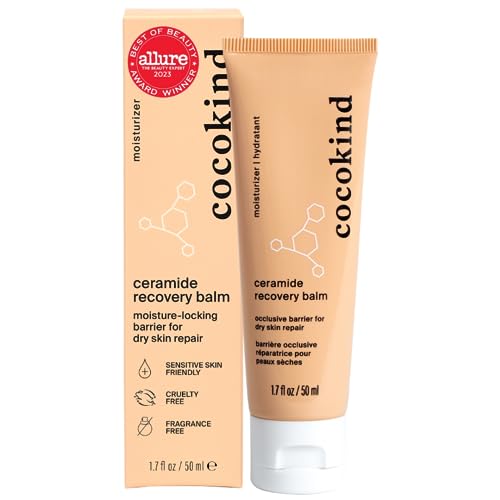
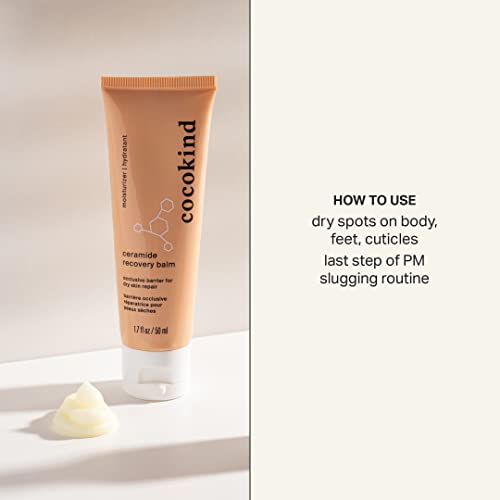
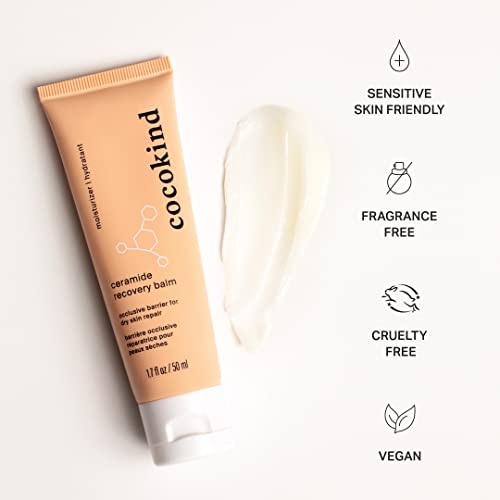
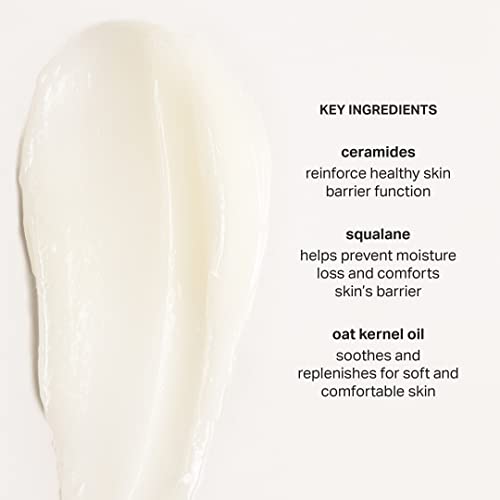
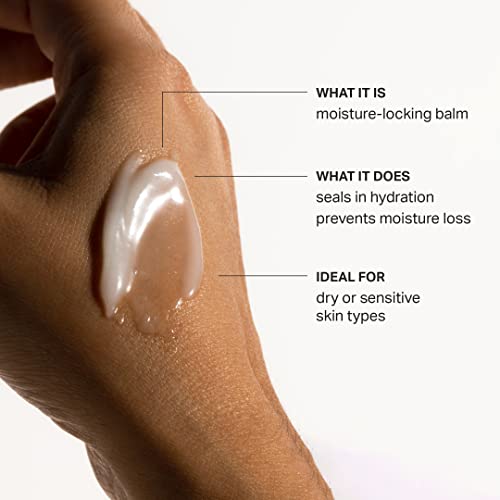
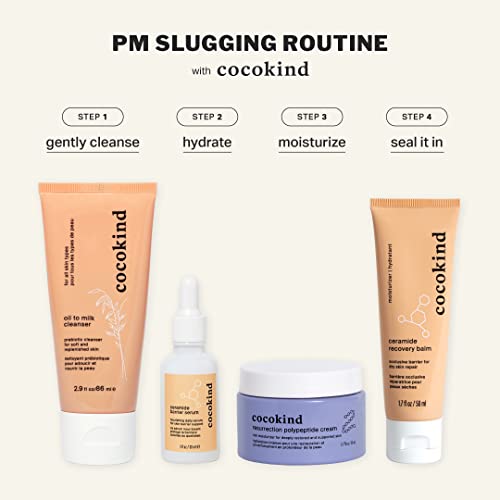
Cocokind Body Balm - Moisture-Locking & Nourishing, Vegan, Mineral Oil-Free - 1.7 Fl Oz


Ricinus Communis (Castor) Seed Oil
Medium RiskCastor oil is extracted from the seeds of Ricinus communis and is commonly used in cosmetic and personal care products for its moisturizing and emollient properties. It is known for its ability to enhance skin absorption and provide a protective barrier.
Sustai Insights
Castor oil offers functional benefits as a moisturizer and emollient, enhancing skin absorption and providing a barrier against moisture loss. It is sustainably sourced and biodegradable. However, potential health risks include low levels of irritation and moderate concerns regarding developmental and reproductive toxicity. Environmental risks are low, with no significant pollutant or bioaccumulation concerns reported. Regulatory status shows no current restrictions. Overall, the risk level is assessed as medium, with recommendations for safe usage practices, and potential alternatives include other plant-based oils.
Glyceryl Laurate
Medium RiskGlyceryl laurate is a monoester of glycerin and lauric acid, commonly used in cosmetic and personal care products. It functions primarily as an emulsifier, helping to blend oil and water components, and can also act as a surfactant, improving product texture and stability.
Sustai Insights
Glyceryl laurate offers functional benefits as an emulsifier and surfactant, enhancing product performance. It has a low risk for cancer, allergies, and developmental toxicity, but moderate use restrictions exist. Environmental concerns are minimal, with no significant pollutant potential or bioaccumulation. Regulatory agencies do not specifically restrict its use. Overall, glyceryl laurate presents a medium risk level, with safe usage recommended and alternatives available for formulation improvements.
Glycerin
Medium RiskGlycerin (also called glycerol) is a naturally occurring compound commonly used in personal care and cosmetic products. It functions as a humectant, attracting moisture to the skin, and is also utilized as a solvent and emollient to enhance product texture and stability.
Sustai Insights
Glycerin is valued for its effective moisturizing properties and biodegradability, making it a widely accepted ingredient in formulations. It poses low health risks, including low concerns for carcinogenicity and allergies. However, moderate use restrictions exist due to regulatory guidelines. While glycerin does not significantly contribute to environmental pollution, its production process should be ethically sourced. Overall, glycerin holds a medium risk level, emphasizing the importance of safe usage practices and considering sustainable alternatives.
Vitis Vinifera (Grape) Seed Oil
Low RiskVitis vinifera (grape) seed oil is derived from the seeds of grapes, primarily used in cosmetics for its emollient properties. It acts as a moisturizer and is often included in formulations for skin care products due to its fatty acid composition and antioxidant potential.
Sustai Insights
Grape seed oil provides functional benefits as an effective moisturizer and antioxidant, contributing to skin hydration and protection. It is sustainably sourced and biodegradable. Health risks are low, with minimal concerns regarding carcinogenicity, allergies, or reproductive toxicity. Environmental impact is also low, with no significant pollutant potential. Regulatory bodies do not impose restrictions on its use. Overall, the ingredient poses a low risk, making it a safe choice in cosmetic formulations.
Carthamus Tinctorius (Safflower) Seed Oil
Low RiskCarthamus tinctorius (safflower) seed oil is derived from the seeds of the safflower plant. It is primarily used in cosmetic formulations for its emollient properties, helping to moisturize and soften the skin. The oil is rich in unsaturated fatty acids and is often employed in skin care products for its potential benefits to skin health.
Sustai Insights
Safflower seed oil offers functional benefits as a moisturizer and emollient, contributing to skin hydration without significant irritation. It is generally recognized as low risk concerning health impacts, with minimal concerns over carcinogenicity, allergies, and reproductive toxicity. Environmentally, it poses low risks, being non-bioaccumulative and not a significant pollutant. Regulatory bodies do not impose restrictions on its use, underscoring its safety profile. While there are no widely recognized safer alternatives, users should ensure proper application to mitigate any potential skin irritation. Overall, this ingredient is assessed as low risk.
Helianthus Annus (Sunflower) Seed Wax
Low RiskHelianthus annuus (sunflower) seed wax is a naturally derived wax obtained from sunflower seeds, primarily used for its emollient properties in cosmetic formulations. It serves as a thickening agent, stabilizer, and moisture-retaining component, contributing to the texture and consistency of various products.
Sustai Insights
Sunflower seed wax offers functional benefits such as enhancing product texture and acting as a natural emulsifier. It is biodegradable and sourced sustainably, which aligns with eco-friendly practices. Health risks associated with this ingredient are low, with no significant concerns regarding carcinogenicity, allergies, or reproductive toxicity noted. Additionally, it does not pose environmental hazards, as it is not classified as a pollutant or bioaccumulative. Regulatory assessments indicate no current restrictions, resulting in an overall low risk level. Safe usage practices should be followed, and while alternatives exist, sunflower seed wax is a suitable option for many formulations.
Squalane
Low RiskSqualane is a naturally occurring lipid found in both plants and animals, primarily derived from olives and sugarcane in cosmetic formulations. It functions as a moisturizer and emollient, aiding in skin hydration and maintaining the skin barrier.
Sustai Insights
Squalane offers functional benefits as an effective moisturizing agent, enhancing skin hydration without clogging pores. It is sustainably sourced, often derived from renewable plant materials. Health risks are minimal, with low concerns regarding carcinogenicity, allergies, and endocrine disruption. Environmental impacts are also low, as squalane is biodegradable. Regulatory bodies have not placed significant restrictions on its use, confirming its safety profile. Overall, squalane is assessed as low risk, making it a favorable ingredient in cosmetic products.
Ceramide Np
Low RiskCeramide NP is a synthetic N-acylated phytosphingosine, primarily used in cosmetics for its role in enhancing skin barrier function and moisture retention. It is a type of ceramide, which is a vital component of the skin's lipid barrier, helping to maintain hydration and protect against environmental stressors.
Sustai Insights
Ceramide NP offers functional benefits as a skin-replenishing agent, effectively improving hydration and barrier integrity. It is considered low risk for health concerns such as cancer, allergies, and developmental toxicity. Environmentally, it poses minimal risks of pollution or bioaccumulation. Regulatory agencies do not impose significant restrictions on its use, affirming its overall safety. Safe usage involves standard cosmetic concentrations, with no significant adverse effects noted. Alternatives may include plant-derived ceramides. Overall, Ceramide NP is assessed to have a low risk.
Ascorbyl Palmitate (Vitamin C Palmitate)
Low RiskAscorbyl palmitate, also known as vitamin C palmitate, is a compound formed by the esterification of ascorbic acid (vitamin C) and palmitic acid. It is primarily used in cosmetic and food products for its antioxidant properties and as a stabilizer for formulations containing fats and oils.
Sustai Insights
Ascorbyl palmitate offers functional benefits as an antioxidant, contributing to product stability and potentially enhancing skin health. It is generally regarded as safe, with low concerns regarding carcinogenicity, allergies, and reproductive toxicity. However, there are considerations regarding biochemical changes at a cellular level, and while it poses minimal environmental risks, it is essential to follow regulatory guidelines. Overall, the risk level is low, making it a suitable ingredient in various applications. Alternatives include other antioxidants like tocopherols for similar benefits.
Lauric Acid
Low RiskLauric acid is a naturally occurring fatty acid commonly found in coconut oil and palm kernel oil. It is primarily used as an emollient, surfactant, and antimicrobial agent in various personal care and cosmetic products due to its potential to enhance product texture and stability.
Sustai Insights
Lauric acid offers functional benefits as an effective emollient and antimicrobial agent, contributing to skin hydration and product preservation. It is biodegradable and derived from renewable sources. Health risks are minimal, with low concerns for carcinogenicity, allergenicity, and reproductive toxicity. Environmental impacts are also low, with no significant pollutant or bioaccumulation potential. Regulatory assessments, including those from the FDA and cosmetic safety reviews, indicate its safe use in products. Overall, lauric acid is considered low risk, making it a viable ingredient in formulations.
Rhus Verniciflua Peel Wax
Low RiskRhus verniciflua peel wax is a wax obtained from the peel of the Rhus verniciflua tree, primarily used in cosmetic and personal care products for its emulsifying and thickening properties. It contributes to product texture and stability.
Sustai Insights
Rhus verniciflua peel wax serves as an effective emulsifier and thickener, enhancing product consistency. It is biodegradable and can be sustainably sourced. Health risks remain low, with no significant concerns regarding carcinogenicity, immunotoxicity, or reproductive toxicity. Environmentally, it poses minimal risks, lacking bioaccumulative properties. Regulatory assessments indicate no restrictions. Overall, it is considered low risk, with safe usage in appropriate concentrations, although alternatives like beeswax or candelilla wax may also be explored.
Polyhydroxystearic Acid
Low RiskPolyhydroxystearic acid is a polymer of hydroxystearic acid, commonly used as an emulsifier and stabilizer in various cosmetic and personal care formulations. It enhances texture and consistency, facilitating the blending of water and oil-based components.
Sustai Insights
Polyhydroxystearic acid functions effectively as an emulsifier, contributing to product stability and texture. It is considered low risk for health concerns such as carcinogenicity, allergies, and developmental toxicity. Environmental assessments indicate minimal pollution and bioaccumulation potential. Regulatory bodies report no current restrictions on its use. Safe usage practices should be followed, although sensitive individuals may experience irritation. Overall, the ingredient is assessed to have a low risk.
Avena Sativa (Oat) Kernel Oil
Low RiskAvena sativa (oat) kernel oil is a fixed oil extracted from the seeds of the oat plant. It is commonly used in cosmetics and skincare products for its moisturizing and nourishing properties, enhancing product texture and stability.
Sustai Insights
Avena sativa (oat) kernel oil offers functional benefits as a moisturizer and skin conditioner, with sustainability credentials due to its biodegradable nature. Health risks are low, with minimal concerns regarding carcinogenicity, allergies, or reproductive toxicity. Environmental impacts are also low, as it does not contribute significantly to pollution or bioaccumulation. Regulatory status is favorable, with no prohibitions noted. Overall, the risk level is assessed as low, making it a safe choice for cosmetic formulations.
Tocopherol
Low RiskTocopherols are a class of naturally occurring compounds, primarily known for their role as antioxidants. They are commonly used in cosmetic and skincare products to help stabilize formulations and protect ingredients from oxidative damage.
Sustai Insights
Tocopherols provide functional benefits such as antioxidant protection and skin conditioning. They are generally recognized as safe, with low concerns regarding carcinogenicity, allergies, and reproductive toxicity. However, enhanced skin absorption and potential endocrine disruption are noted. Regulatory bodies have not imposed significant restrictions on tocopherols, categorizing the overall risk as low. Safe usage practices should be observed, and while alternatives exist, tocopherols remain a viable option in formulations.
Cetearyl Alcohol
Low RiskCetearyl alcohol is a mixture of cetyl and stearyl alcohol, primarily used as an emulsifier and thickener in cosmetic formulations. It helps stabilize products, improve texture, and enhance moisturizing properties, making it common in creams and lotions.
Sustai Insights
Cetearyl alcohol offers functional benefits as an effective emulsifier and skin-conditioning agent, contributing to product stability and texture. It is generally recognized as safe, with low concerns for carcinogenicity, allergies, or reproductive toxicity. Environmental risks are minimal, as it is biodegradable and has low pollutant potential. Regulatory bodies have not imposed significant restrictions on its use. Overall, cetearyl alcohol is assessed to carry low risk, making it a suitable ingredient choice in cosmetic products.
Butyrospermum Parkii (Shea) Butter
Low RiskButyrospermum parkii (shea) butter is a vegetable fat derived from the nuts of the shea tree. It is commonly used in cosmetic formulations for its emollient properties, providing moisture and improving skin texture. Additionally, shea butter is known for its ability to enhance the stability of products and deliver a creamy texture.
Sustai Insights
Shea butter offers functional benefits as an effective moisturizer, enhancing skin barrier function and texture. It is sustainably sourced and biodegradable, contributing to eco-friendliness. Health-wise, it is associated with low risks for carcinogenicity, allergies, and reproductive toxicity. Environmental impacts are minimal, with no significant pollutant potential identified. Regulatory assessments indicate no current restrictions. Overall, the ingredient presents a low risk, making it a favorable choice in cosmetic formulations.
Helianthus Annuus (Sunflower) Seed Oil
Low RiskHelianthus annuus (sunflower) seed oil is derived from the seeds of the sunflower plant. It serves primarily as an emollient and moisturizer in cosmetic formulations, helping to maintain skin hydration and improve texture.
Sustai Insights
Sunflower seed oil is effective as an emollient, providing moisture and improving skin texture while being biodegradable and sustainably sourced. It poses low health risks, including negligible concerns for carcinogenicity, allergies, or reproductive toxicity. Environmentally, it does not significantly contribute to pollution or bioaccumulation. Regulatory bodies currently do not list any advisories for this ingredient. Overall, it is assessed as low risk, with safe usage practices recommended. Alternatives include oils like jojoba or almond oil for those seeking different properties.
Ricinus Communis (Castor) Seed Oil
Medium RiskCastor oil is extracted from the seeds of Ricinus communis and is commonly used in cosmetic and personal care products for its moisturizing and emollient properties. It is known for its ability to enhance skin absorption and provide a protective barrier.
Sustai Insights
Castor oil offers functional benefits as a moisturizer and emollient, enhancing skin absorption and providing a barrier against moisture loss. It is sustainably sourced and biodegradable. However, potential health risks include low levels of irritation and moderate concerns regarding developmental and reproductive toxicity. Environmental risks are low, with no significant pollutant or bioaccumulation concerns reported. Regulatory status shows no current restrictions. Overall, the risk level is assessed as medium, with recommendations for safe usage practices, and potential alternatives include other plant-based oils.
Glyceryl Laurate
Medium RiskGlyceryl laurate is a monoester of glycerin and lauric acid, commonly used in cosmetic and personal care products. It functions primarily as an emulsifier, helping to blend oil and water components, and can also act as a surfactant, improving product texture and stability.
Sustai Insights
Glyceryl laurate offers functional benefits as an emulsifier and surfactant, enhancing product performance. It has a low risk for cancer, allergies, and developmental toxicity, but moderate use restrictions exist. Environmental concerns are minimal, with no significant pollutant potential or bioaccumulation. Regulatory agencies do not specifically restrict its use. Overall, glyceryl laurate presents a medium risk level, with safe usage recommended and alternatives available for formulation improvements.
Vitis Vinifera (Grape) Seed Oil
Low RiskVitis vinifera (grape) seed oil is derived from the seeds of grapes, primarily used in cosmetics for its emollient properties. It acts as a moisturizer and is often included in formulations for skin care products due to its fatty acid composition and antioxidant potential.
Sustai Insights
Grape seed oil provides functional benefits as an effective moisturizer and antioxidant, contributing to skin hydration and protection. It is sustainably sourced and biodegradable. Health risks are low, with minimal concerns regarding carcinogenicity, allergies, or reproductive toxicity. Environmental impact is also low, with no significant pollutant potential. Regulatory bodies do not impose restrictions on its use. Overall, the ingredient poses a low risk, making it a safe choice in cosmetic formulations.
Carthamus Tinctorius (Safflower) Seed Oil
Low RiskCarthamus tinctorius (safflower) seed oil is derived from the seeds of the safflower plant. It is primarily used in cosmetic formulations for its emollient properties, helping to moisturize and soften the skin. The oil is rich in unsaturated fatty acids and is often employed in skin care products for its potential benefits to skin health.
Sustai Insights
Safflower seed oil offers functional benefits as a moisturizer and emollient, contributing to skin hydration without significant irritation. It is generally recognized as low risk concerning health impacts, with minimal concerns over carcinogenicity, allergies, and reproductive toxicity. Environmentally, it poses low risks, being non-bioaccumulative and not a significant pollutant. Regulatory bodies do not impose restrictions on its use, underscoring its safety profile. While there are no widely recognized safer alternatives, users should ensure proper application to mitigate any potential skin irritation. Overall, this ingredient is assessed as low risk.
Helianthus Annus (Sunflower) Seed Wax
Low RiskHelianthus annuus (sunflower) seed wax is a naturally derived wax obtained from sunflower seeds, primarily used for its emollient properties in cosmetic formulations. It serves as a thickening agent, stabilizer, and moisture-retaining component, contributing to the texture and consistency of various products.
Sustai Insights
Sunflower seed wax offers functional benefits such as enhancing product texture and acting as a natural emulsifier. It is biodegradable and sourced sustainably, which aligns with eco-friendly practices. Health risks associated with this ingredient are low, with no significant concerns regarding carcinogenicity, allergies, or reproductive toxicity noted. Additionally, it does not pose environmental hazards, as it is not classified as a pollutant or bioaccumulative. Regulatory assessments indicate no current restrictions, resulting in an overall low risk level. Safe usage practices should be followed, and while alternatives exist, sunflower seed wax is a suitable option for many formulations.
Squalane
Low RiskSqualane is a naturally occurring lipid found in both plants and animals, primarily derived from olives and sugarcane in cosmetic formulations. It functions as a moisturizer and emollient, aiding in skin hydration and maintaining the skin barrier.
Sustai Insights
Squalane offers functional benefits as an effective moisturizing agent, enhancing skin hydration without clogging pores. It is sustainably sourced, often derived from renewable plant materials. Health risks are minimal, with low concerns regarding carcinogenicity, allergies, and endocrine disruption. Environmental impacts are also low, as squalane is biodegradable. Regulatory bodies have not placed significant restrictions on its use, confirming its safety profile. Overall, squalane is assessed as low risk, making it a favorable ingredient in cosmetic products.
Ceramide Np
Low RiskCeramide NP is a synthetic N-acylated phytosphingosine, primarily used in cosmetics for its role in enhancing skin barrier function and moisture retention. It is a type of ceramide, which is a vital component of the skin's lipid barrier, helping to maintain hydration and protect against environmental stressors.
Sustai Insights
Ceramide NP offers functional benefits as a skin-replenishing agent, effectively improving hydration and barrier integrity. It is considered low risk for health concerns such as cancer, allergies, and developmental toxicity. Environmentally, it poses minimal risks of pollution or bioaccumulation. Regulatory agencies do not impose significant restrictions on its use, affirming its overall safety. Safe usage involves standard cosmetic concentrations, with no significant adverse effects noted. Alternatives may include plant-derived ceramides. Overall, Ceramide NP is assessed to have a low risk.
Ascorbyl Palmitate (Vitamin C Palmitate)
Low RiskAscorbyl palmitate, also known as vitamin C palmitate, is a compound formed by the esterification of ascorbic acid (vitamin C) and palmitic acid. It is primarily used in cosmetic and food products for its antioxidant properties and as a stabilizer for formulations containing fats and oils.
Sustai Insights
Ascorbyl palmitate offers functional benefits as an antioxidant, contributing to product stability and potentially enhancing skin health. It is generally regarded as safe, with low concerns regarding carcinogenicity, allergies, and reproductive toxicity. However, there are considerations regarding biochemical changes at a cellular level, and while it poses minimal environmental risks, it is essential to follow regulatory guidelines. Overall, the risk level is low, making it a suitable ingredient in various applications. Alternatives include other antioxidants like tocopherols for similar benefits.
Lauric Acid
Low RiskLauric acid is a naturally occurring fatty acid commonly found in coconut oil and palm kernel oil. It is primarily used as an emollient, surfactant, and antimicrobial agent in various personal care and cosmetic products due to its potential to enhance product texture and stability.
Sustai Insights
Lauric acid offers functional benefits as an effective emollient and antimicrobial agent, contributing to skin hydration and product preservation. It is biodegradable and derived from renewable sources. Health risks are minimal, with low concerns for carcinogenicity, allergenicity, and reproductive toxicity. Environmental impacts are also low, with no significant pollutant or bioaccumulation potential. Regulatory assessments, including those from the FDA and cosmetic safety reviews, indicate its safe use in products. Overall, lauric acid is considered low risk, making it a viable ingredient in formulations.
Rhus Verniciflua Peel Wax
Low RiskRhus verniciflua peel wax is a wax obtained from the peel of the Rhus verniciflua tree, primarily used in cosmetic and personal care products for its emulsifying and thickening properties. It contributes to product texture and stability.
Sustai Insights
Rhus verniciflua peel wax serves as an effective emulsifier and thickener, enhancing product consistency. It is biodegradable and can be sustainably sourced. Health risks remain low, with no significant concerns regarding carcinogenicity, immunotoxicity, or reproductive toxicity. Environmentally, it poses minimal risks, lacking bioaccumulative properties. Regulatory assessments indicate no restrictions. Overall, it is considered low risk, with safe usage in appropriate concentrations, although alternatives like beeswax or candelilla wax may also be explored.
Polyhydroxystearic Acid
Low RiskPolyhydroxystearic acid is a polymer of hydroxystearic acid, commonly used as an emulsifier and stabilizer in various cosmetic and personal care formulations. It enhances texture and consistency, facilitating the blending of water and oil-based components.
Sustai Insights
Polyhydroxystearic acid functions effectively as an emulsifier, contributing to product stability and texture. It is considered low risk for health concerns such as carcinogenicity, allergies, and developmental toxicity. Environmental assessments indicate minimal pollution and bioaccumulation potential. Regulatory bodies report no current restrictions on its use. Safe usage practices should be followed, although sensitive individuals may experience irritation. Overall, the ingredient is assessed to have a low risk.
Avena Sativa (Oat) Kernel Oil
Low RiskAvena sativa (oat) kernel oil is a fixed oil extracted from the seeds of the oat plant. It is commonly used in cosmetics and skincare products for its moisturizing and nourishing properties, enhancing product texture and stability.
Sustai Insights
Avena sativa (oat) kernel oil offers functional benefits as a moisturizer and skin conditioner, with sustainability credentials due to its biodegradable nature. Health risks are low, with minimal concerns regarding carcinogenicity, allergies, or reproductive toxicity. Environmental impacts are also low, as it does not contribute significantly to pollution or bioaccumulation. Regulatory status is favorable, with no prohibitions noted. Overall, the risk level is assessed as low, making it a safe choice for cosmetic formulations.
Glycerin
Medium RiskGlycerin (also called glycerol) is a naturally occurring compound commonly used in personal care and cosmetic products. It functions as a humectant, attracting moisture to the skin, and is also utilized as a solvent and emollient to enhance product texture and stability.
Sustai Insights
Glycerin is valued for its effective moisturizing properties and biodegradability, making it a widely accepted ingredient in formulations. It poses low health risks, including low concerns for carcinogenicity and allergies. However, moderate use restrictions exist due to regulatory guidelines. While glycerin does not significantly contribute to environmental pollution, its production process should be ethically sourced. Overall, glycerin holds a medium risk level, emphasizing the importance of safe usage practices and considering sustainable alternatives.
Tocopherol
Low RiskTocopherols are a class of naturally occurring compounds, primarily known for their role as antioxidants. They are commonly used in cosmetic and skincare products to help stabilize formulations and protect ingredients from oxidative damage.
Sustai Insights
Tocopherols provide functional benefits such as antioxidant protection and skin conditioning. They are generally recognized as safe, with low concerns regarding carcinogenicity, allergies, and reproductive toxicity. However, enhanced skin absorption and potential endocrine disruption are noted. Regulatory bodies have not imposed significant restrictions on tocopherols, categorizing the overall risk as low. Safe usage practices should be observed, and while alternatives exist, tocopherols remain a viable option in formulations.
Cetearyl Alcohol
Low RiskCetearyl alcohol is a mixture of cetyl and stearyl alcohol, primarily used as an emulsifier and thickener in cosmetic formulations. It helps stabilize products, improve texture, and enhance moisturizing properties, making it common in creams and lotions.
Sustai Insights
Cetearyl alcohol offers functional benefits as an effective emulsifier and skin-conditioning agent, contributing to product stability and texture. It is generally recognized as safe, with low concerns for carcinogenicity, allergies, or reproductive toxicity. Environmental risks are minimal, as it is biodegradable and has low pollutant potential. Regulatory bodies have not imposed significant restrictions on its use. Overall, cetearyl alcohol is assessed to carry low risk, making it a suitable ingredient choice in cosmetic products.
Butyrospermum Parkii (Shea) Butter
Low RiskButyrospermum parkii (shea) butter is a vegetable fat derived from the nuts of the shea tree. It is commonly used in cosmetic formulations for its emollient properties, providing moisture and improving skin texture. Additionally, shea butter is known for its ability to enhance the stability of products and deliver a creamy texture.
Sustai Insights
Shea butter offers functional benefits as an effective moisturizer, enhancing skin barrier function and texture. It is sustainably sourced and biodegradable, contributing to eco-friendliness. Health-wise, it is associated with low risks for carcinogenicity, allergies, and reproductive toxicity. Environmental impacts are minimal, with no significant pollutant potential identified. Regulatory assessments indicate no current restrictions. Overall, the ingredient presents a low risk, making it a favorable choice in cosmetic formulations.
Helianthus Annuus (Sunflower) Seed Oil
Low RiskHelianthus annuus (sunflower) seed oil is derived from the seeds of the sunflower plant. It serves primarily as an emollient and moisturizer in cosmetic formulations, helping to maintain skin hydration and improve texture.
Sustai Insights
Sunflower seed oil is effective as an emollient, providing moisture and improving skin texture while being biodegradable and sustainably sourced. It poses low health risks, including negligible concerns for carcinogenicity, allergies, or reproductive toxicity. Environmentally, it does not significantly contribute to pollution or bioaccumulation. Regulatory bodies currently do not list any advisories for this ingredient. Overall, it is assessed as low risk, with safe usage practices recommended. Alternatives include oils like jojoba or almond oil for those seeking different properties.
Discover the Cocokind Ceramide Recovery Balm, a 2023 Allure Best of Beauty Winner that melts effortlessly into the skin, providing intensive moisture where it’s needed most. This vegan, mineral oil-free, and petrolatum-free balm is designed for environmentally conscious consumers seeking effective skin nourishment without harmful ingredients.
- Ultimate Hydration: Locks in moisture with ceramides, making it perfect for dry spots, cuticles, and nighttime slugging.
- Versatile Use: Ideal for all skin types, it can be applied generously on various areas, ensuring complete coverage.
- Eco-Friendly: Cocokind prioritizes sustainability with earth-friendly formulations, supporting the skin without compromising the planet.
- Enhanced Benefits: For optimal results, pair with the Cocokind Ceramide Barrier Serum to fortify your skin barrier.
- Trusted Quality: Backed by numerous positive reviews, this balm is crafted with nourishing ingredients like shea butter and squalane, ensuring a radiant, healthy complexion.
Experience the gentle yet powerful formulation that promotes glowy, happy skin while caring for the environment.
Subscribe & Save with Sustai
- Best Price Guarantee: Always enjoy the lowest prices on sustainable home essentials.
- No Surprises: We’ll notify you before shipping. No hidden fees, ever.
- You’re in Charge: Change, pause, or cancel your subscription anytime with ease.
- Eco-Friendly Deliveries: Our grouped shipments mean less packaging and lower emissions.
Join us on a sustainable journey. Special offers for a limited time! Prices and promotions may change.
Recommended Products
Discover the Cocokind Ceramide Recovery Balm, a 2023 Allure Best of Beauty Winner that melts effortlessly into the skin, providing intensive moisture where it’s needed most. This vegan, mineral oil-free, and petrolatum-free balm is designed for environmentally conscious consumers seeking effective skin nourishment without harmful ingredients.
- Ultimate Hydration: Locks in moisture with ceramides, making it perfect for dry spots, cuticles, and nighttime slugging.
- Versatile Use: Ideal for all skin types, it can be applied generously on various areas, ensuring complete coverage.
- Eco-Friendly: Cocokind prioritizes sustainability with earth-friendly formulations, supporting the skin without compromising the planet.
- Enhanced Benefits: For optimal results, pair with the Cocokind Ceramide Barrier Serum to fortify your skin barrier.
- Trusted Quality: Backed by numerous positive reviews, this balm is crafted with nourishing ingredients like shea butter and squalane, ensuring a radiant, healthy complexion.
Experience the gentle yet powerful formulation that promotes glowy, happy skin while caring for the environment.

You can have at most 2 Sustainable Steals products in your cart
Customer Reviews
Customers’ View
Customers express a generally positive sentiment towards Cocokind's Ceramide Recovery Balm, highlighting its effective moisturizing and skin-softening properties. Many users appreciate how it hydrates dry skin and supports a healthy skin barrier, with comments such as, "It’s super hydrating but not greasy," and "It leaves my skin feeling really soft for hours." The product's formulation, which includes beneficial ingredients like ceramides, resonates well with health-conscious consumers. Additionally, several reviews commend its value for money, indicating satisfaction with the product's affordability. However, opinions on the texture vary, with some finding it perfect while others describe it as gritty. Overall, this balm aligns well with eco-friendly values, as it is crafted with clean, sustainable ingredients, making it a reliable choice for those seeking effective, responsible skincare.
AI-generated from the text of customer reviewsThis product is rated 4.8 of 5.0 stars.
It has received 8 reviews.




